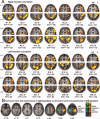Cerebral lateralization of praxis in right- and left-handedness: same pattern, different strength
- PMID: 21500314
- PMCID: PMC6870330
- DOI: 10.1002/hbm.21247
Cerebral lateralization of praxis in right- and left-handedness: same pattern, different strength
Abstract
We aimed to investigate the effect of hand effector and handedness on the cerebral lateralization of pantomiming learned movements. Fourteen right-handed and 14 left-handed volunteers performed unimanual and bimanual tool-use pantomimes with their dominant or nondominant hand during fMRI. A left hemispheric lateralization was observed in the right- and left-handed group regardless of which hand(s) performed the task. Asymmetry was most marked in the dorsolateral prefrontal cortex (DLPFC), premotor cortex (PMC), and superior and inferior parietal lobules (SPL and IPL). Unimanual pantomimes did not reveal any significant differences in asymmetric cerebral activation patterns between left- and right-handers. Bimanual pantomimes showed increased left premotor and posterior parietal activation in left- and right-handers. Lateralization indices (LI) of the 10% most active voxels in DLPFC, PMC, SPL, and IPL were calculated for each individual in a contrast that compared all tool versus all control conditions. Left-handers showed a significantly reduced overall LI compared with right-handers. This was mainly due to diminished asymmetry in the IPL and SPL. We conclude that the recollection and pantomiming of learned gestures recruits a similar left lateralized activation pattern in right and left-handed individuals. Handedness only influences the strength (not the side) of the lateralization, with left-handers showing a reduced degree of asymmetry that is most readily observed over the posterior parietal region. Together with similar findings in language and visual processing, these results point to a lesser hemispheric specialization in left-handers that may be considered in the cost/benefit assessment to explain the disproportionate handedness polymorphism in humans.
Copyright © 2011 Wiley Periodicals, Inc.
Figures




References
Publication types
MeSH terms
LinkOut - more resources
Full Text Sources
Medical

